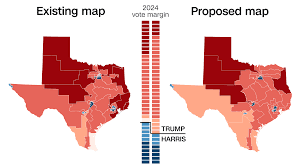There is no truly good way to give representative voices to a population. The founders of the country decided that there would be a set number of congresional representatives, divided it by states, and left it to the individual states to subdivide, with a few provisos. They mandated that congressional districts have to be contiguous, entirely within a state, and contain approximately the same number of citizens in each. A later law specified that the districts should not directly disadvantage a racial minority. Within these parameters, legislators in most states have divided congressional districts to advantage those in power to a greater or lesser extent. The most egregious of these are Gerrymanders, odd shaped districts that protect sitting congressmen and parties, as bad as the worst of these are, they are better than some, truly awful, “fair” divisions, in my opinion.

Consider my state: Michigan, a swing state that voted for both Biden, and Trump. Currently the state house is 52% R and 48% D, but Democrats were in majority as recently as 2024. Our congressional district map used to be a disaster, shown at left. In 2022 it was replaced by a map created by an independent committee that aimed for roughly square districts that aimed to keep towns and communities together. The result is that most districts are either safe D or safe R. This, we’re told, is bad in that it leads to factionalism, with congressmen pandering to political extremes, with little incentive to compromise.
A fairer alternative (?) would divide the congressional districts so that all or most district are swing, like the state. Supposedly such districts would elect moderates who compromise. This version, though no-less fair than the above, is not good, in my opinion. I expect it creates chaos and turnover. I’m also not convinced that compromise is always best.

The variant of this that preceded our current is for congressmen and others in power to create districts that are fairly safe for themselves and their party, leaving those of the other party in a few, super-concentrated districts. This division is less fair, but far more stable and workable. It lead to ugly gerrymander districts in Michigan (left) and Pennsylvania (below). This is not bad in itself. What was bad about these gerrymanders is that the congress folk, secure in their jobs, formed a political aristocracy. Seats passed from generation to generation, and ruled fairly disconnected from the wishes of those they represented. A good part of the aristocracy is that they worked well with each other, across party lines. They were friends, alumni of the same schools, members of the same churches and country clubs. They were good-‘ol-boys, who didn’t pander nor embrace ideological extremes. Writers romanticize this, but I’ prefer our current’m glad it’s going in MI.
California and Texas politicians are pushing for more gerrymandering. California’s congressional districts were drawn by independent committee. Their governor called the Trump White House fascists as recently as today. There’s a vote to get five more D-districts. The claim is it’s to balance Texas’s push for three more R-districts. I nothing illegal or immoral here, just old style politics, power grabs left and right, with incendiary language. The districts look bad, but I’ve seen worse. No need to call ‘fascist’ unless your next step is to impeach president Trump again, or your hope is another shooting.
The worst option, in my opinion is term limits. It’s promoted from both sides, and I consider it insane, except for party bosses. It actively prevents people from re-electing the politicians they like based on the objection that these people have been on the job long enough to feel at home and get things done. I consider term limits completely non-republican, non-democratic, a disease, “fair” only in that it hurts every citizen equally, benefitting only party bosses.
Robert Buxbaum, September 27, 2025



















